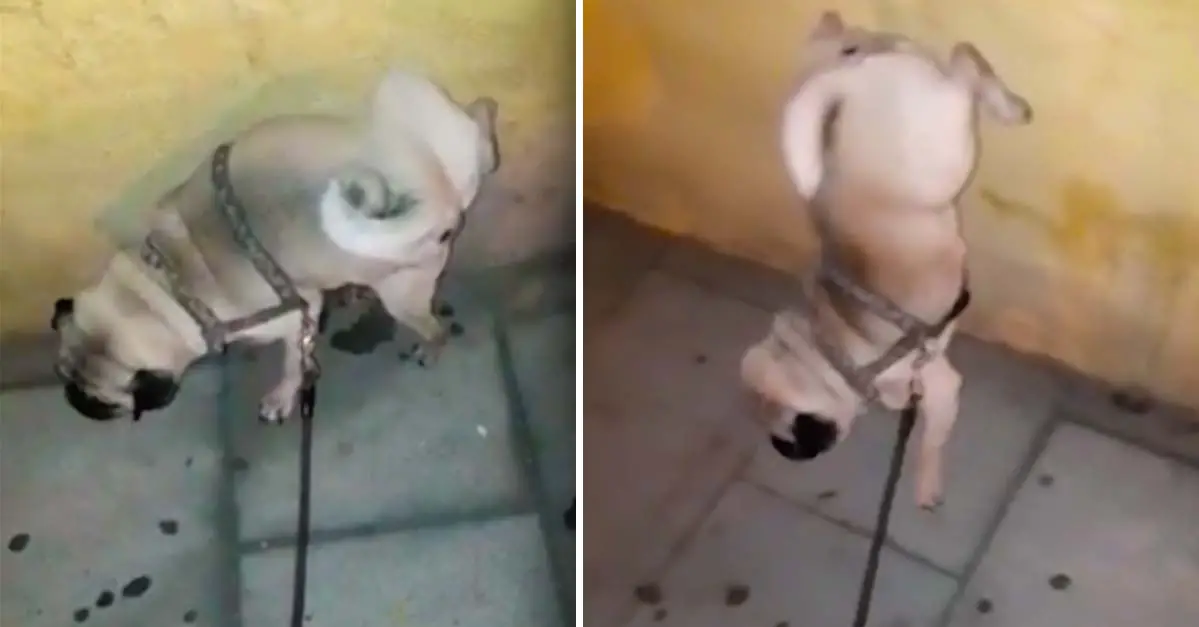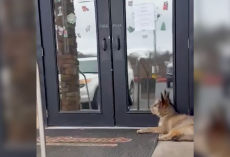This pug marks his territory in a very unique way.
Why Do Some Dogs Pee on Their Front Paws?
There isn't one reason why dogs pee on their own legs, as various factors could contribute to this behavior. Dogs sometimes urinate on their paws for a number of different reasons, including their anatomy, natural instincts, medical conditions and more. Here are some top factors that contribute to paw peeing:
- Anatomy — The anatomy of some dogs may make it more difficult for them to point their urine away from their body. As a result, their front paws may get wet.
- Natural instinct — Dogs use urination as a way to show submission and avoid conflict. This behavior can be exhibited when they meet new people or other dogs. Alternatively, they may urinate when they're in a situation that makes them feel uneasy or stressed.
- Marking territory — Urinating on their front paws allows dogs to mark their territory more effectively. This is especially true for male dogs, who often lift their legs to pee.
In addition to the above possible factors, it may also simply be the case that the dog in question is not used to peeing just yet – especially true if they’re only a puppy. Let’s dig a bit deeper into each point so that you have an idea of how to address paw peeing in the particular case with your dog.
Your Dog Is Not Used to Peeing Just Yet
They see the If you want your dog to follow your commands and perform tricks, training is required. What you may not realize is that training is also required if you want your pet to change some of their odd habits, such as peeing on their own paws.
Because although initially this may seem a funny quirk, it can also impact their hygiene and health in the long-term. So if your puppy constantly urinates on its front legs, this could simply be because your pet isn't used to aiming properly when they pee.
Your dog may eventually grow out of this particular habit and be able to pee without hitting its front legs. So give some time to your dog to learn and practice.
This can often be a trait demonstrated by rescue dogs, who have never undergone proper potty training. So remember that patience is key as they adjust!
The Issue Is Caused by Your Dog's Anatomy
Puppies may pee on their front legs because they don't understand what they're doing yet. Like with our previous point, there’s a good chance that the problem will resolve itself on its own.
Unfortunately, other issues that may cause your dog to pee on his front legs are more difficult – or at least less straightforward – to resolve.
For example, it could be the case that your dog's messy urination is caused by an issue with his anatomy – such as with a misaligned penis, where the penis of your dog could be aimed directly at his front legs.
Because of this, it may be difficult for your dog to redirect his urine. Hip or leg problems could also explain why your dog always urinates on his legs, as your pet may not be able to position his body so that it can avoid his legs.
Your Dog Is Marking His Territory
Apart from peeing to relieve themselves, dogs pee for several other purposes. One of the additional reasons for peeing is because they’re marking their territory. In the usual “peeing posture”, male dogs pee and their urine does not spread out too much.
However in order to mark more locations, your pet may aim to spray a wider area, to cover more ground and mark a larger territory. Your dog may even get into a handstand posture to urinate further than usual.
Whatever his posture, if your dog is aiming to mark a wider territory, this will in all likelihood increase the chances that he squirt some pee on his front legs.
How to Stop My Dog from Peeing on His Front Legs?
Urine gives out an unpleasant smell when it dries on your dog's fur. It may also irritate your nose if you have to breathe it in constantly. Worse yet, urine from your dog's front legs might get on your furnishings and flooring if he starts to rush about the house.
So, how to prevent your male dog from urinating on his front legs? What actions ought you take to prevent this from happening? We’ve listed some top tips below, which may help you to tackle your own dog’s peeing problems.
Help them position properly
You can assist your male dog in positioning himself correctly, especially useful if they have trouble pointing their pee away from their body.
For instance, you can use your foot to push their back leg up into a higher position when they begin to raise their leg to pee; this should cause the urine to flow sideways rather than forward.
With repetition, your pup may eventually pick up the proper “safe peeing position” that prevents paw wetness.
Keep the hair at the end of their privates a bit longer (for males)
If your dog pees on his front legs as a result of an anatomical issue, you may need to tackle this peeing issue a little differently.
For example, you may need to do a little extra grooming around the bottom and genital area. To divert your dog's pee, you should leave some hair longer close to his penis.
The reason for this is that the fur should then send the pee downward rather than up onto your dog's front legs. Your dog’s genital area will still need to be cleaned, but it won't be as hard as washing dried pee from your dog's legs.
Approach an Animal Behaviorist for Assistance
You might need to speak with an animal behaviorist, if your pet's peculiar peeing habits are the result of his urge to mark everything in his environment.
After a few sessions, your dog may no longer feel the compulsion to handstand while he urinates or mark his territory so extensively.
The expert will teach your dog how to urinate in a more controlled manner and will also provide you with advice on how to interact with your pet to avoid paw urination.
In Conclusion
If your dog is peeing on his front legs, then don’t despair. Once you’ve identified the reasons potentially causing this totally potty behavior, then it’ll be 10x easier to put the proper measures in place to help rectify his misguided aim.
If you’re at all concerned with your dog’s potty habits or would like expert support, don’t hesitate to get in touch with your veterinarian who may be able to offer specialized support and guidance.











